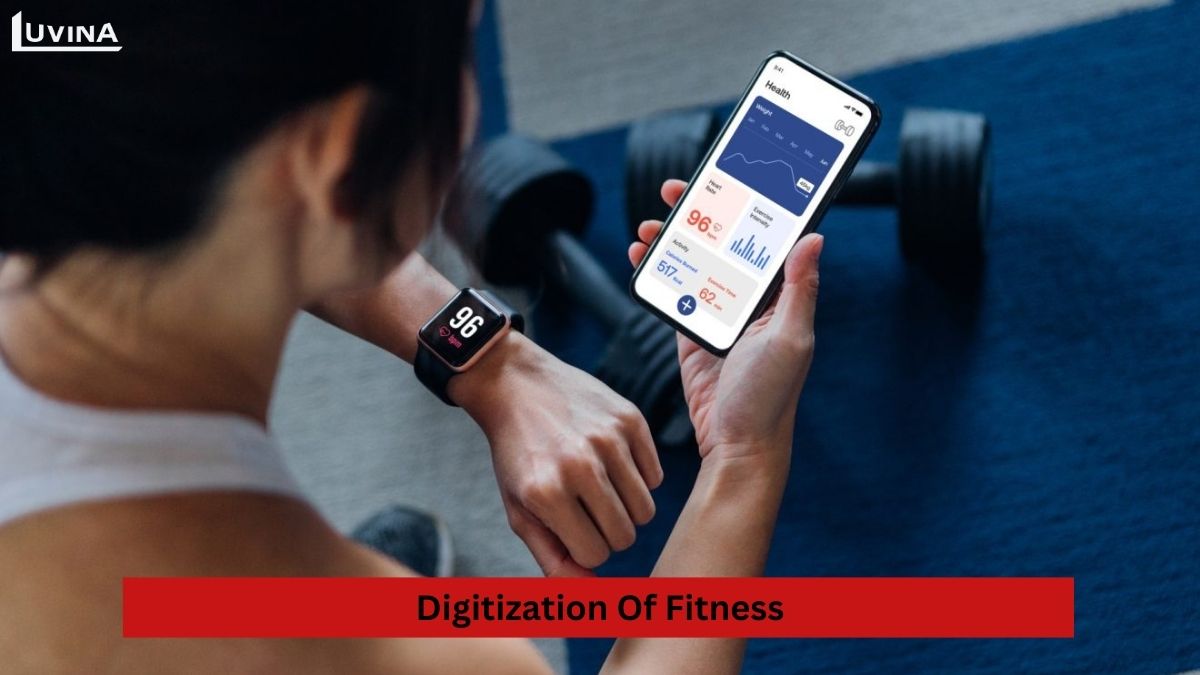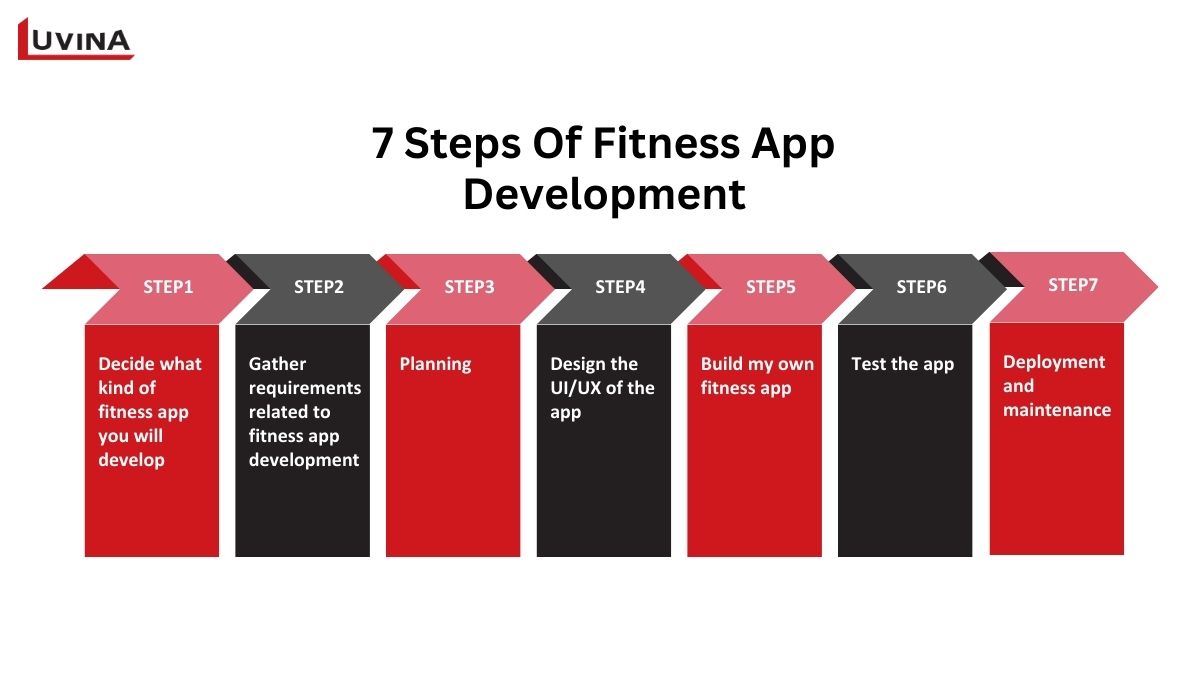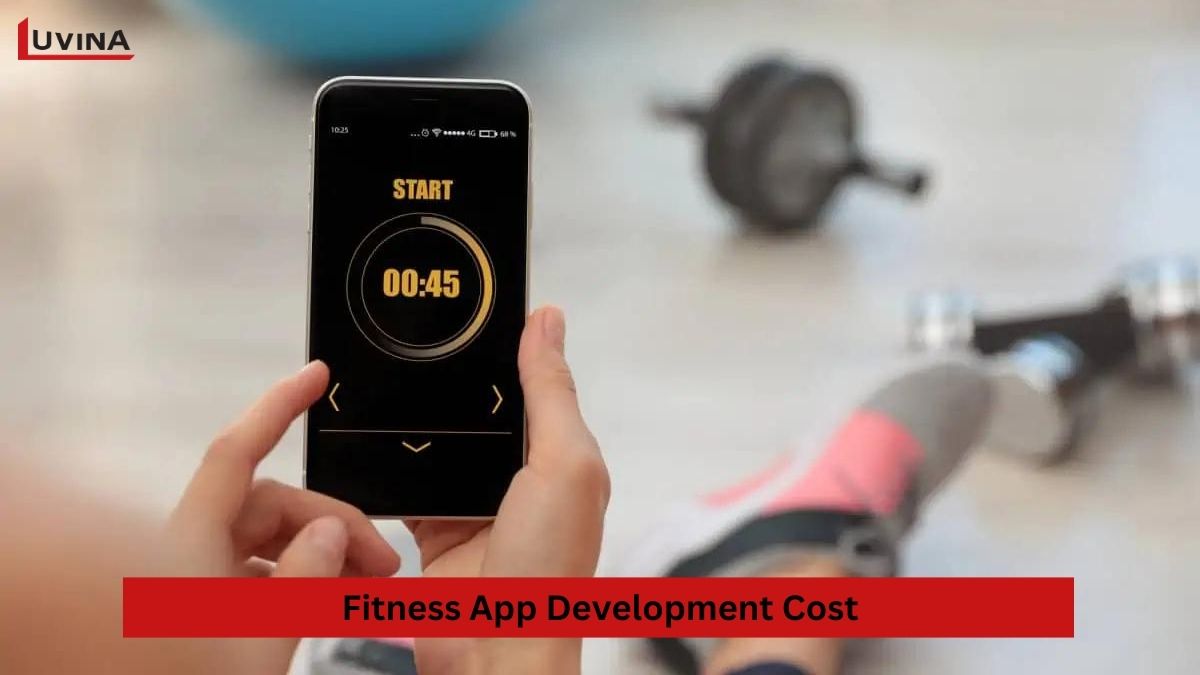If you’re looking to acquire the knowledge and tips required for a successful fitness app development process, you’re in the right place. Developing a fitness app is one of the best ways for your business to leverage this booming industry and achieve full high profits. As one of the leading mobile application development companies, Luvina will provide you with practical insights into the fitness application development market in the article below and offer a comprehensive guide to help you create your own fitness app. Let’s get started!
Overview of Fitness Apps
In the context of technology continuously transforming various industries, the fitness market has seized this opportunity with leading apps like Peloton, Fit Body, and Nike Training Club, all generating massive profits. Currently, about 70% of users see fitness apps as an attractive addition to their in-person gym workouts. According to Statista, the revenue in the fitness application development market is projected to grow at an annual rate of 14.34% between 2023 and 2027, leading to an estimated market volume of $33.04 billion by 2027.

Among the countries worldwide, the U.S. is taking the lead in fitness mobile app development. Eight out of every ten fitness apps come from the U.S. More than half of American users are also leaning towards a blend of virtual and real-world fitness experiences, fostering a dynamic hybrid fitness culture. As of this year, over 44.5 million adults in the U.S. are using connected fitness platforms at least once a month.
These figures demonstrate that fitness app development is a promising trend for businesses to tap into this industry while achieving high ROI.
Types of Fitness Apps
In fitness app development, businesses can choose from various types of apps to meet different user needs. Below are some popular types of applications that many companies opt for when looking to create a fitness app:

- Workout and Exercise Apps (e.g., Nike Training Club, Peloton): Businesses build a workout app to offer guided exercises and workout plans to customers. Most of the time, these include video or audio tutorials that guide the user through the workout.
- Activity Tracking Apps (e.g., Fitbit, Apple Health): Developed by fitness app developers, these apps are designed to integrate with wearable devices or phone sensors for monitoring physical activities, such as step counting, elevation tracking, running speed, and a whole lot more. They also collect and analyze sports activity data.
- Diet and Nutrition Apps (e.g., MyFitnessPal): This is one of the most common types in fitness app development, helping users build a healthier lifestyle by providing detailed information on balanced diets. Besides this, the application can allow its users to log their calorie intake, track weight, and provide free healthy recipes.
- Yoga and Meditation Apps (e.g., Calm, Headspace): Most of these apps practically take people through meditation, breathing, and other techniques to reduce anxiety and improve sleep quality so they may be at peace with themselves.
- Personal Trainer Apps (e.g., Trainiac): Businesses build this type of fitness app to offer users a personal trainer, ensuring safe workouts and reducing injury risks. The app can analyze users’ movements and provide feedback on their techniques and exercises. Some apps also recommend suitable workout equipment for users.
Key Features of a Fitness App
To build your own fitness app successfully, ensuring smooth operation and meeting user needs, the app must be integrated with the best features to stand out in today’s digital fitness market. Below are some of the top features we believe businesses should include when engaging in fitness app development.
| No. | Features | Descriptions |
| 1 | User Profiles and Personalization | User profiles and personalization bring benefits to both users and businesses when they make a fitness app. This feature helps app developers create an app tailored to users’ workout habits and fitness activities. For users, it makes it easy to access subscription plans, workout routines, and reward progress. |
| 2 | Workout Plans and Routines | This feature allows users to create their own workout routines and search for suitable exercises from a library based on their fitness goals. |
| 3 | Activity Tracking | With this feature, the app can collect data in two ways: through smartphone sensors or by integrating the app with any wearable device. When integrated during fitness app development, this feature can track various metrics such as steps, stairs climbed, distance traveled, speed, direction, heart rate, sleep quality, body temperature, and more. |
| 4 | Nutrition and Diet Tracking | To create a fitness app, businesses should not overlook meal planning and calorie tracking. The best nutrition and diet tracking apps on the market today provide detailed information about food ingredients, suggest recipes based on user goals, preferences, and health conditions, and allow users to track their food intake. |
| 5 | Gamification and Challenges | With elements like badges, milestones, and the ability to share achievements on social media to compete with friends, your fitness app can motivate users to hit important goals, enjoy their workouts, and stay engaged with both the app and their fitness journey. |
| 6 | Live Streaming and Virtual Classes | This feature is highly beneficial for group workouts or personal training sessions. Live streaming and virtual classes offer an immersive experience, making users feel like they’re attending a real training center. |
| 7 | Push Notifications and Reminders | Research shows that well-timed messages can increase app retention rates by 3 to 10 times. Integrating push notifications and reminders during fitness application development keeps users engaged with the app and motivated to continue their workouts. Fitness app notifications should generally not exceed 90 characters and are best sent between 7-8 AM or 12-2 PM. You can also allow users to customize reminder times and manage push notifications. |
| 8 | Progress Reports and Analytics | Weekly and monthly progress reports help users track their workout progress, boost motivation, and understand their fitness journey better. When you create a fitness app, it’s important to visualize workout goals and progress through charts, graphs, progress bars, statistics, and other visual elements. |
How to Develop a Fitness App: Step-by-Step Guide
How to create my own fitness app is a question many organizations and individuals make in the scenario of digitalization for the fitness and wellness industry. If you’re also planning to make your own fitness app, here is a 7-step process with proper guidance specifically for you.

Step 1: Decide what kind of fitness app you will develop
First of all, you should identify the kind of fitness app you are going to create to attract your targeted audience and make it unique from others that may already exist. Start with an overview of a few highly-rated health apps in the market that may help you narrow down your idea for a fitness whether that’s a meditation app or a workout app. The key is the identification of an urgent problem that needs a resolution, checking the profitability of the niche market, and hence making the right decision from there.
Step 2: Gather requirements related to fitness app development
In this step, you need to define all of your business needs to build an app that meets your exact requirements. Gathering these requirements early ensures that fitness app developers understand your needs and deliver the results you expect. You can either define your requirements yourself or seek help from experienced fitness app developers.
Step 3: Planning
Having identified the type of application to be developed along with the features that you want to include in it, now it’s time to create a preliminary plan to develop your own fitness app. In this respect, the plan would summarize some of the key things to note during development, such as the cost, timeline, information about the team, technical packages, and more.
Step 4 – Design the UI/UX of the app
In fitness app development, the goal of UX/UI design is simplicity and easy navigation. Based on user characteristics and market analysis, your UI/UX designers will create several prototypes and test them with a focus group of target users. Building these prototypes helps identify any issues and opportunities related to the app’s functionality.
A prototype in fitness application development is a preliminary version of your app’s interface, starting with a low-fidelity design and moving toward more refined designs that resemble the final app. The prototype that receives the most positive feedback will become the final draft for your future app’s interface. After that, the final screen layouts will be handed over to the development team.
Step 5 – Build my own fitness app
This is the stage where fitness app developers start building the app. According to experts, the whole fitness app development process needs to be divided into sprint phases, which would last for approximately two weeks. The project manager will play a major role in prioritizing tasks that need to be tracked while managing the product backlog. Dividing the process into these phases makes it easier to manage and ensures that the project stays on track.
Step 6 – Test the app
After developing a fitness app, the Quality Assurance team tests the application for bugs and smooth functionality on each of the target platforms and devices. Besides that, the QA team will execute both functional and non-functional tests that validate the performance and usability of the app. Testing requires quite some time, but it is among the most significant phases of fitness application development. Your app may get rejected in the app stores due to a lack of proper testing. Hence, the facilitation of sufficient time and effort in this regard is highly recommended.
Step 7 – Deployment and maintenance
Once the app is functioning as required, it will be deployed to app stores. Make sure to thoroughly research the app store requirements before launching the app across different platforms.
Moreover, after the app is launched and accepted by users, continuous monitoring and improvement are essential. This process involves the entire app development team and includes tracking KPIs, gathering user feedback, analyzing issues, fixing bugs, and enhancing the app’s functionality.
Cost of Fitness App Development
According to experts, developing an MVP (Minimum Viable Product) for a fitness app can cost between $25,000 and $30,000. However, to create a fully-featured fitness app, the cost can range from $60,000 to $160,000. The exact figure depends on various factors such as app requirements, the geographical location of the developers, the app’s complexity, and the different development stages.
Additionally, the integration of modern technologies will greatly impact the fitness app development cost. For example, some apps may require AI or machine learning technologies, or integration with hardware such as voice assistance or video streaming.

For a more detailed breakdown of fitness app development costs, let’s explore the following sections.
- App Complexity
Fitness app development cost depends a lot on the complexity of the application. Features and functionalities determine the complexity of the application. The more you do, incorporating features, the more complex the app will become.
For example, the development of a simple fitness application with functions of login/ logout, integration with a wearable device, a dashboard, and a list of workouts will cost in the range of $15,000 to $60,000. At the same time, developing a complex fitness app includes advanced functionality such as live streaming, on-demand video, video tutorials, and virtual coaches, which ultimately costs around $65,000 to $120,000.
- Platform
In general, there are two major platforms for fitness mobile app development: Android and iOS. If you go with native development, therefore developing two apps targeting each of the platforms, the cost of your fitness app development will definitely increase because now you will be required to support two codebases. On the other hand, cross-platform can save you loads of money.
On average, a cross-platform application can cost anything between $9,000 and $25,000, while native app development is expected to take from $12,000 to $30,000.
- Location of Development Team
Fitness app development costs will also vary depending on where the team of developers is located: Europe, Asia, or North America.
For instance, in the United States and Canada, the developer hourly rates amount to $100-$250. In Western Europe, it was $80-$150 per hour. In Eastern Europe, the rates fall to $25-$100 per hour. In India and other parts of Asia, the rates of developers go a notch lower and fall in the range of $20 to $50 per hour. With this in mind, it simply means that if you opt to work with developers based in regions such as Asia-for instance, India-the overall cost of creating your fitness app will be way cheaper compared to if you had to work with developers in North America or Western Europe.
Challenges and Solutions in Fitness App Development
Like the development of many other applications, fitness app development is not an easy process. Therefore, it is completely understandable that you encounter challenges during this process. We believe that the four challenges below will cause you the most overwhelming obstacles in the pursuit of a developed fitness application. Fortunately, these are some of those challenges you can combat ahead of time.
1. Privacy and Data Security
Fitness applications often handle sensitive health data, so the app needs to have a high level of security and ensure compliance with regulations. In the present context, when cyberattacks are becoming the new normal, offering an extra bit of security to the fitness app becomes necessary.

You need to ensure your application meets data protection regulatory requirements like GDPR and HIPAA to protect the user’s information and gain user trust. Furthermore, you can implement biometric authentication, multi-factor verification methods, and other actions that guarantee data storage safety. Gaining user trust through security measures will help your app stand out from competitors in the market.
2. User Retention and Engagement
One of the major challenges that has been associated with fitness application development is bridging the gap between users excited on day one and those who are committed to using the app over a longer period of time. Many users have high expectations when downloading the app but struggle to use it consistently on a daily basis. Therefore, your app needs to incorporate elements that can keep users engaged.
Some strategies for retaining and engaging users include using push notifications, integrating gamification elements, organizing challenges, and providing highly personalized experiences. You can also build a community, as users often want to feel they belong to a group.
Through features like sharing on forums or social media, you can allow users to connect, share experiences, support each other, and foster a collaborative and developmental environment. By addressing the challenges related to user interaction and engagement, businesses can create a more engaging and sustainable experience.
3. Integration with Wearable Devices
With the rapid growth in the wearables device market, seamless integration of your fitness application with wearables like smartwatches and fitness trackers will be very crucial to establishing a strong presence in this vertical. You should ensure that your application can integrate smoothly with these devices, particularly with Bluetooth protocols, and support various data formats.

Notably, in some cases, wearable devices may provide inaccurate data on step counts or heart rates, leading to discrepancies when updating the app. You need to address these inconsistencies to enhance user trust in your application.
Future Trends in Fitness App Development
In the future, fitness app development will continue to thrive with the emergence of several modern trends outlined below.
- AI and Machine Learning: Applications will continue to analyze data, biometric activity, and fitness goals, all thanks to AI and machine learning support, and then create personalized programs in line with users’ needs and preferences. AI can also act as a virtual personal trainer, bringing about an immersive workout experience for users.
- Virtual Reality Workouts: Workouts will be fun because virtual reality and augmented reality are the features that eliminate the excuse of no time for workouts in this busy, technologically savvy life. Users would not need to go out to the gym or have to search for videos to work out; instead, now users can enjoy an immersive workout from the comfort of their homes.
- Increased Integration with Wearables: This is already a trend now, but soon it’s going to be much more robust. The accuracy of tracking and providing health information in detail will also improve. Users will be in a better position to track their physical and health goals by using advanced technology in fitness mobile app development. While monitoring, simultaneously recording vital data, which will help in diagnosing and treating various health conditions, will also become possible.
- Social Fitness and Communities: With the integration of social features in fitness app development, community plays a core role in health journeys. Building a platform where users can share, compete, and support each other will give rise to a sense of belonging and responsibility.
Conclusion
Fitness application development, like developing any other application, can be quite challenging. However, we believe that the information and detailed guidance provided above will help you answer the question of how to make your own fitness app successfully.
If you are planning to create your own fitness app, please contact Luvina. Luvina is currently one of the best fitness development companies in Vietnam and Asia, with extensive experience in developing applications across various industries. We are always ready to listen to your needs and leverage all available resources to create the most innovative solutions in fitness app development.
Ready to turn your fitness app idea into reality? Contact Luvina today for a free consultation on cost, features, and development roadmap.









Read More From Us?
Sign up for our newsletter
Read More From Us?
Sign up for our newsletter